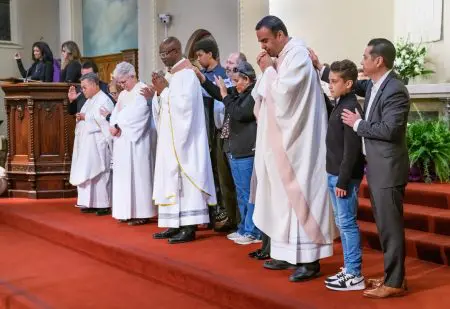
The Sacrament of Holy Orders: Sharing in the Priesthood of Christ
According to the Catechism of the Catholic Church, the Sacrament of Holy Orders is “the sacrament of apostolic ministry” (CCC 1536). It is the means by which Christ continues His mission in the Church through those called to serve as deacons, priests, and bishops.
What Does “Holy Orders” Mean?
The term ordination comes from the Latin word ordinatio, meaning “to incorporate into an order.” In the Roman Empire, an “order” referred to an established civil or governing body. The Church adopted this concept to designate specific groups with distinct roles and responsibilities within the Christian community.
In the early Church, there were several “orders,” such as the order of catechumens, virgins, and widows. Today, we’re also familiar with religious orders—communities devoted to particular charisms. In the Sacrament of Holy Orders, a man is incorporated into the priesthood of Christ, entering into one of three distinct orders: the diaconate, the priesthood, or the episcopate. According to the Catechism and the documents of Vatican II, episcopal ordination is considered the fullness of this sacrament (CCC 1557).
The Priesthood of Christ
The concept of priesthood has deep roots in salvation history. In the Old Testament, God appointed the tribe of Levi to serve as priests, offering sacrifices and prayers on behalf of the people. Jesus, the eternal High Priest, fulfilled and transformed this priesthood by offering Himself as the perfect sacrifice for the redemption of the world.
This self-offering is made present in every celebration of the Eucharist. In this way, the ministerial priesthood of the New Covenant is not merely symbolic—it participates in the one eternal priesthood of Christ.
All baptized believers share in the common priesthood by living lives of faith, hope, and charity. However, the ministerial priesthood, conferred through Holy Orders, is distinct and serves the common priesthood. Through this sacrament, Christ continues to build, teach, and sanctify His Church (CCC 1547).
Three Degrees of the Sacrament
While there is only one Sacrament of Holy Orders, it is conferred in three degrees:
1. The Episcopate (Bishop)
Bishops are successors to the Apostles and receive the fullness of the sacrament. They are ordained by other bishops—usually several—to ensure continuity through apostolic succession. A bishop is entrusted with the responsibility to sanctify, teach, and govern the Church. He has the authority to ordain others and is the visible head of a diocese.
2. The Presbyterate (Priest)
Priests are ordained to assist the bishop in his ministry. They are his co-workers, especially in preaching the Gospel, celebrating the Eucharist, and administering the sacraments. At ordination, a priest promises obedience to his bishop and commits himself to a life of service to God’s people.
3. The Diaconate (Deacon)
Deacons assist bishops and priests in ministry, especially in the proclamation of the Gospel, service to the poor, and certain sacramental functions like baptisms and witnessing marriages. Deacons do not celebrate Mass or hear confessions. The permanent diaconate h was restored after Vatican II and is now open to married men.
Who Can Be Ordained?
The Sacrament of Holy Orders may be conferred only on baptized, confirmed Catholic men who have also received the Eucharist. A man cannot demand ordination—it is a call discerned by the Church, and the Church retains the authority to determine eligibility.
In the Latin (Western) Church, celibacy is the norm for priestly ordination.
The Rite of Ordination
The essential elements of the sacrament include:
The laying on of hands by a bishop,
A consecratory prayer, asking God for the outpouring of the Holy Spirit and the specific gifts needed for the ministry.
While traditional elements like celebrating the ordination in a cathedral, during Mass, and on a Sunday are customary, they are not strictly required.
Who Ministers the Sacrament?
Only a bishop, by virtue of his apostolic succession, can validly confer the Sacrament of Holy Orders. His ordination empowers him to share the sacramental ministry of Christ and to extend it through the ordination of others.
The Effects of Holy Orders
Like Baptism and Confirmation, Holy Orders imprints an indelible spiritual character on the soul and can only be received once at each level. This is why the saying exists: “Once a priest, always a priest.”
Even if a priest is later released from clerical duties or forbidden to function publicly, the spiritual mark remains. Each degree of the sacrament confers particular graces:
Deacons: Grace to serve and proclaim the Word.
Priests: Grace to act in the person of Christ in the sacraments, especially the Eucharist.
Bishops: Grace to teach, govern, and sanctify the Church with apostolic authority.
